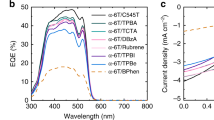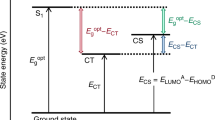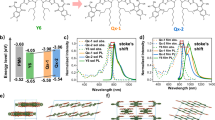Abstract
Energy loss within organic solar cells (OSCs) is undesirable as it reduces cell efficiency1,2,3,4. In particular, non-radiative recombination loss3 and energetic disorder5, which are closely related to the tail states below the band edge and the overall photon energy loss, need to be minimized to improve cell performance. Here, we report how the use of a small-molecule acceptor with torsion-free molecular conformation can achieve a very low degree of energetic disorder and mitigate energy loss in OSCs. The resulting single-junction OSC has an energy loss due to non-radiative recombination of just 0.17 eV and a high power conversion efficiency of up to 16.54% (certified as 15.89% by the National Renewable Energy Laboratory). The findings take studies of organic photovoltaics deeper into a new regime, beyond the limits of energetic disorder and large energy offset for charge generation.
This is a preview of subscription content, access via your institution
Access options
Access Nature and 54 other Nature Portfolio journals
Get Nature+, our best-value online-access subscription
$29.99 / 30 days
cancel any time
Subscribe to this journal
Receive 12 print issues and online access
$209.00 per year
only $17.42 per issue
Buy this article
- Purchase on Springer Link
- Instant access to full article PDF
Prices may be subject to local taxes which are calculated during checkout




Similar content being viewed by others
Data availability
The data that support the plots within this paper and other findings of this study are available from the corresponding authors upon reasonable request. Raw data essential to the work are available online as Source Data files.
Code availability
Computer code used to generate results (to calculate the spontaneous emission rate, simulate maximum open-circuit voltage, generate fits to the spectral features in EL spectra) for this study is available from the corresponding author (H.W.) upon request.
References
Hou, J. H., Inganas, O., Friend, R. H. & Gao, F. Organic solar cells based on non-fullerene acceptors. Nat. Mater. 17, 119–128 (2018).
Qian, D. P. et al. Design rules for minimizing voltage losses in high-efficiency organic solar cells. Nat. Mater. 17, 703–709 (2018).
Kirchartz, T. & Rau, U. What makes a good solar cell? Adv. Energy Mater. 8, 1703385 (2018).
Yao, J. Z. et al. Quantifying losses in open-circuit voltage in solution-processable solar cells. Phys. Rev. Appl. 4, 014020 (2015).
Venkateshvaran, D. et al. Approaching disorder-free transport in high-mobility conjugated polymers. Nature 515, 384–388 (2014).
Zhang, S., Qin, Y., Zhu, J. & Hou, J. Over 14% efficiency in polymer solar cells enabled by a chlorinated polymer donor. Adv. Mater. 30, 1800868 (2018).
Yuan, J. et al. Single-junction organic solar cell with over 15% efficiency using fused-ring acceptor with electron-deficient core. Joule 3, 1140–1151 (2019).
Cui, Y. et al. Over 16% efficiency organic photovoltaic cells enabled by a chlorinated acceptor with increased open-circuit voltages. Nat. Commun. 10, 2515 (2019).
Fan, B. et al. Achieving over 16% efficiency for single-junction organic solar cells. Sci. China Chem. 62, 746–752 (2019).
Meng, L. X. et al. Organic and solution-processed tandem solar cells with 17.3% efficiency. Science 361, 1094–1098 (2018).
Yoshikawa, K. et al. Silicon heterojunction solar cell with interdigitated back contacts for a photoconversion efficiency over 26%. Nat. Energy 2, 17032 (2017).
Liu, Z. F. et al. Open-circuit voltages exceeding 1.26 V in planar methylammonium lead iodide perovskite solar cells. ACS Energy Lett. 4, 110–117 (2018).
Cheng, P., Li, G., Zhan, X. W. & Yang, Y. Next-generation organic photovoltaics based on non-fullerene acceptors. Nat. Photon. 12, 131–142 (2018).
Gruber, M. et al. Thermodynamic efficiency limit of molecular donor–acceptor solar cells and its application to diindenoperylene/C60-based planar heterojunction devices. Adv. Energy Mater. 2, 1100–1108 (2012).
Liu, J. et al. Fast charge separation in a non-fullerene organic solar cell with a small driving force. Nat. Energy 1, 16089 (2016).
Blakesley, J. C. & Neher, D. Relationship between energetic disorder and open-circuit voltage in bulk heterojunction organic solar cells. Phys. Rev. B 84, 075210 (2011).
Craciun, N. I., Wildeman, J. & Blom, P. W. M. Universal Arrhenius temperature activated charge transport in diodes from disordered organic semiconductors. Phys. Rev. Lett. 100, 056601 (2008).
Garcia-Belmonte, G. et al. Influence of the intermediate density-of-states occupancy on open-circuit voltage of bulk heterojunction solar cells with different fullerene acceptors. J. Phys. Chem. Lett. 1, 2566–2571 (2010).
Collins, S. D., Proctor, C. M., Ran, N. A. & Nguyen, T.-Q. Understanding open-circuit voltage loss through the density of states in organic bulk heterojunction solar cells. Adv. Energy Mater. 6, 1501721 (2016).
Garcia-Belmonte, G. & Bisquert, J. Open-circuit voltage limit caused by recombination through tail states in bulk heterojunction polymer-fullerene solar cells. Appl. Phys. Lett. 96, 113301 (2010).
Kuik, M., Koster, L. J. A., Wetzelaer, G. A. H. & Blom, P. W. M. Trap-assisted recombination in disordered organic semiconductors. Phys. Rev. Lett. 107, 256805 (2011).
Xie, S. K. et al. Effects of nonradiative losses at charge transfer states and energetic disorder on the open-circuit voltage in nonfullerene organic solar cells. Adv. Funct. Mater. 28, 1705659 (2018).
He, Z. et al. Single-junction polymer solar cells with high efficiency and photovoltage. Nat. Photon. 9, 174–179 (2015).
Ran, N. A. et al. Harvesting the full potential of photons with organic solar cells. Adv. Mater. 28, 1482–1488 (2016).
Zhang, Z. H. et al. Conformation locking on fused-ring electron acceptor for high performance nonfullerene organic solar cells. Adv. Funct. Mater. 28, 1705095 (2018).
Wang, Y. M. et al. Optical gaps of organic solar cells as a reference for comparing voltage losses. Adv. Energy Mater. 8, 1801352 (2018).
Rau, U. Reciprocity relation between photovoltaic quantum efficiency and electroluminescent emission of solar cells. Phys. Rev. B 76, 085303 (2007).
Rau, U., Blank, B., Müller, T. C. M. & Kirchartz, T. Efficiency potential of photovoltaic materials and devices unveiled by detailed-balance analysis. Phys. Rev. Appl. 7, 044016 (2017).
Markvart, T. Solar cell as a heat engine: energy–entropy analysis of photovoltaic conversion. Phys. Stat. Sol. 205, 2752–2756 (2008).
Miller, O. D., Yablonovitch, E. & Kurtz, S. R. Strong internal and external luminescence as solar cells approach the Shockley–Queisser limit. IEEE J. Photovolt. 2, 303–311 (2012).
Nikolis, V. C. et al. Reducing voltage losses in cascade organic solar cells while maintaining high external quantum efficiencies. Adv. Energy Mater. 7, 1700855 (2017).
Ullbrich, S. et al. Emissive and charge-generating donor–acceptor interfaces for organic optoelectronics with low voltage losses. Nat. Mater. 18, 459–464 (2019).
Azzouzi, M. et al. Nonradiative energy losses in bulk-heterojunction organic photovoltaics. Phys. Rev. X 8, 031055 (2018).
Kirchartz, T., Pieters, B. E., Kirkpatrick, J., Rau, U. & Nelson, J. Recombination via tail states in polythiophene:fullerene solar cells. Phys. Rev. B 83, 115209 (2011).
Kirchartz, T. & Nelson, J. Meaning of reaction orders in polymer:fullerene solar cells. Phys. Rev. B 86, 165201 (2012).
Urbach, F. The long-wavelength edge of photographic sensitivity and of the electronic absorption of solids. Phys. Rev. 92, 1324–1324 (1953).
Gong, W. et al. Influence of energetic disorder on electroluminescence emission in polymer:fullerene solar cells. Phys. Rev. B 86, 024201 (2012).
Vandewal, K., Tvingstedt, K., Gadisa, A., Inganäs, O. & Manca, J. V. Relating the open-circuit voltage to interface molecular properties of donor:acceptor bulk heterojunction solar cells. Phys. Rev. B 81, 125204–125211 (2010).
Menke, S. M. et al. Order enables efficient electron–hole separation at an organic heterojunction with a small energy loss. Nat. Commun. 9, 277 (2018).
Hörmann, U. et al. Quantification of energy losses in organic solar cells from temperature-dependent device characteristics. Phys. Rev. B 88, 235307 (2013).
Acknowledgements
H.W. thanks the National Natural Science Foundation of China for financial support (no. 51521002). Y.Z. acknowledges the National Natural Science Foundation of China (no. 21875286), the National Key Research & Development Projects of China (no. 2017YFA0206600) and the Science Fund for Distinguished Young Scholars of Hunan Province (2017JJ1029). Z.H. acknowledges the National Natural Science Foundation of China for financial support (nos. 51622302 and 21733005). We thank T. Song and H. Meng for solar cell performance verification, J. Zhang for acquiring GIWAXS analysis and B. Xiao for temperature-dependent current–voltage characteristics measurements. We thank S. Bilson for proof reading.
Author information
Authors and Affiliations
Contributions
Y.Z. and H.W. conceived the idea. S.L. fabricated and characterized the devices. Y.Z., J.Y. and M.L. designed the molecule structure of the electron acceptor, and J.Y. and M.L. synthesized the compound. W.D. and S.L. performed sensitive EQE, EL, photoluminescence and temperature-dependent photovoltage/photocurrent characteristics measurements. W.D. carried out analysis of the EL spectra and temperature-dependent photovoltage characteristics, and carried out the transient absorption measurements. Y.X. determined the optical gap, the energy of the charge transfer states of the absorbers and carried out IQE measurements. J.Y. performed morphological characterization. Q.L. performed transient photovoltage and transient photocurrent measurements. S.L. and Z.H. prepared and brought samples to NIM for certification. S.L. coordinated solar cells performance verification at NREL and prepared the samples. H.W., Y.Z. and Y.C. coordinated the project. H.W. and Y.Z. wrote the manuscript, while all authors contributed to data analysis, interpretation and discussion of the results.
Corresponding authors
Ethics declarations
Competing interests
The authors declare no competing interests.
Additional information
Publisher’s note Springer Nature remains neutral with regard to jurisdictional claims in published maps and institutional affiliations.
Extended data
Extended Data Fig. 1 The context page of test report by the National Renewable Energy Laboratory (NREL).
a, The test summary for a champion cell (#892-b) tested under the initial asymptotic scan. The asymptotic scan was measured through holding the device at the bias near the maximal power condition. b, The test summary for the cell tested in the second round asymptotic scan. c, The test summary for the cell tested under the standard sweep condition.
Extended Data Fig. 2 Photon energy loss analysis on the devices investigated in this study.
Device parameters of representative devices from various photovoltaic material systems in literature are also included for comparison.
Supplementary information
Supplementary Information
Supplementary Figs. 1–18, Tables 1 and 2, and references.
Source data
Source Data Fig. 2
Absorbance spectra Source Data.
Source Data Fig. 3
Current density–voltage (J–V) characteristics and EQE spectra Source Data of the best-performing OSCs.
Source Data Fig. 4
The measured EL spectrum, the experimental EQE spectrum and the deduced EQE spectrum determined from the EL spectrum Source Data.
Source Data Extended Data Fig. 1
Test report by NREL Source Data.
Rights and permissions
About this article
Cite this article
Liu, S., Yuan, J., Deng, W. et al. High-efficiency organic solar cells with low non-radiative recombination loss and low energetic disorder. Nat. Photonics 14, 300–305 (2020). https://doi.org/10.1038/s41566-019-0573-5
Received:
Accepted:
Published:
Issue Date:
DOI: https://doi.org/10.1038/s41566-019-0573-5
This article is cited by
-
Assessing intra- and inter-molecular charge transfer excitations in non-fullerene acceptors using electroabsorption spectroscopy
Nature Communications (2024)
-
Physical insights into non-fullerene organic photovoltaics
Nature Reviews Physics (2024)
-
Selenium substitution for dielectric constant improvement and hole-transfer acceleration in non-fullerene organic solar cells
Nature Communications (2024)
-
Suppressing electron-phonon coupling in organic photovoltaics for high-efficiency power conversion
Nature Communications (2023)
-
Advantages, challenges and molecular design of different material types used in organic solar cells
Nature Reviews Materials (2023)



